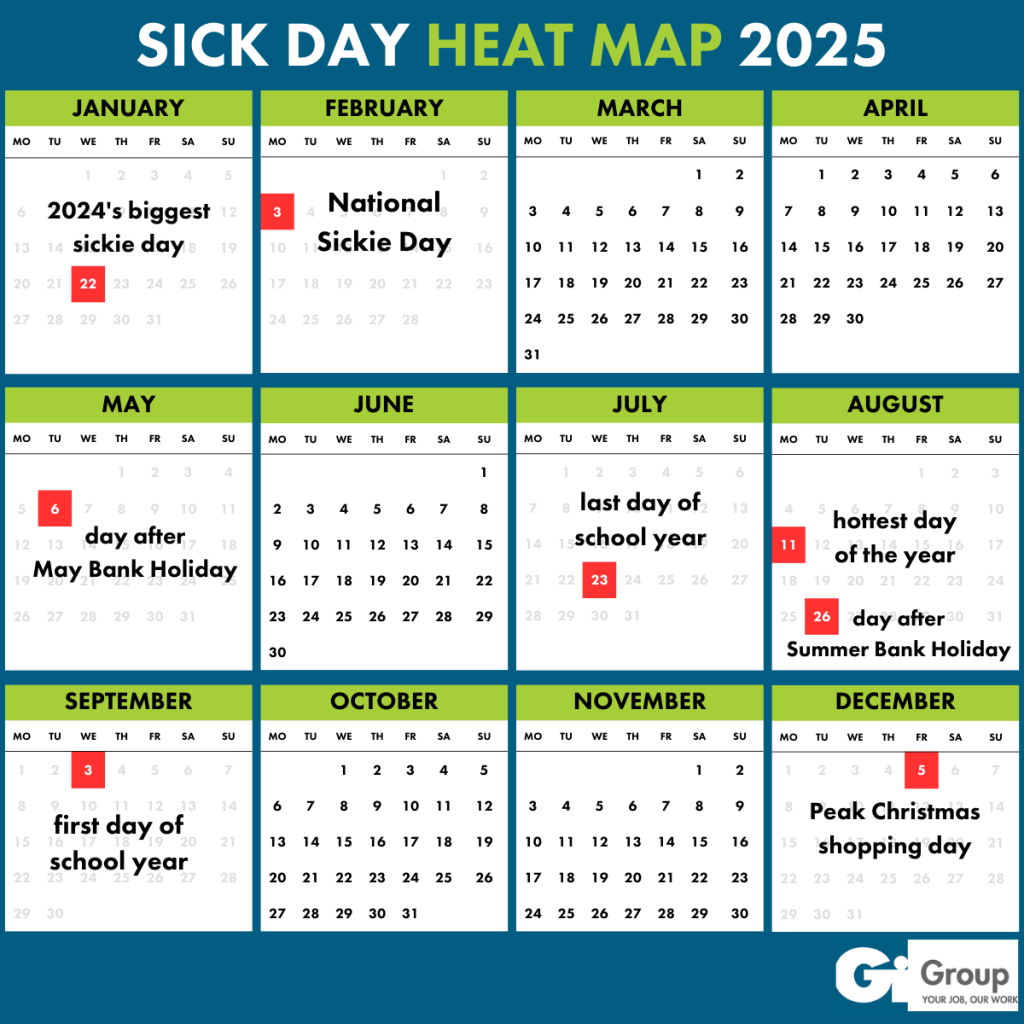Outlining the red-letter days for employee sick leave, Gi Group – one of the UK’s leading HR and Recruitment specialists- is sharing annual trends to predict absenteeism across the UK in 2025.
Since 2011, the first Monday in February has been dubbed ‘National Sickie Day,’ however Gi Group has thrown doubt on the veracity of one single national sick day – explaining that there are actually multiple ‘popular’ sick days through the year for employers to take note of.
According to Statista in 2023/24 there were approximately 33.7 million working days lost in Great Britain due to work-related injury or illness. Though Sickie Day is supposedly the leading day for absenteeism, in 2024 January 22nd took pole position with a staggering 5,871 absences.
But is there any rhyme or reason to these numbers? Gi Group is revealing the likely days and dates – in its own ‘sick day heat map’ – that people will take off throughout 2025 to support business leaders find a proactive approach to combat absenteeism.

Cindy Gunn, Group Head of People, commented: “It is undeniable that February brings the freezing weather, lingering seasonal blues and an influx of cold and flu. From burnout and mental health challenges to a common cold, there are a number of elements contributing to increased sick leave, leaving employers with a difficult challenge in how best to support employees while also tackling rising absence rates.
“The UK has seen a backdrop of rising employee absences since 2019, totalling 55 per cent, but the reasoning for sick leave remains varied with serious illness, childcare challenges, infections and allergies in the top five reasons. It is important to note that depending on the industry, sick leave data does vary. For example, the hospitality, recruitment, financial and entertainment industries all lead the way for sick leave with notable increases since 2019.”
According to the most recent data, Monday is the day with the highest level of sick leave as employees are twice as likely to take leave on a Monday or Friday than any other day of the week.
Cindy continued: “When discussing the heat map of employee sick leave throughout the year, it is important to recognise the key sickness trends. Why is it that Monday is the most likely day for sick leave? Is it possible ‘Sunday Scaries’ are increasing the volume of illness on Mondays, or are there specific dates that seem to create more interest than others?”
Sunday Scaries are feelings of anxiety and dread that people experience as the weekend ends and the workweek begins. According to the most recent data, seven out of 10 Britons experience these feelings as the new work-week looms.
Cindy added: “Key dates to note are – late night national and international sporting events, pay days, extreme weather changes, the day after Bank Holidays and, for many parents, the start and end of school terms.
“If employers start to recognise these patterns forming it is important they take notice of why. Is there a negative workplace culture forming, is your team feeling valued, do you recognise and support individual development, and do you offer your team appropriate wellbeing care? All these questions can help to get businesses talking about underlying reasons behind absenteeism rates and what can be done to support affective structures to tackle these issues.
“It is important to recognise when an employer or employee may be abusing the company trust, but taking this opportunity to provide a re-structured framework is an important developmental step. Why are your team members taking sick leave and do you provide workplace benefits that can counteract employee challenges?”
Research has found that Gen Z workers take an average of 14.3 sick days per year, compared to ‘Boomers’ with 8.9 sick days. The data also highlighted that over half of employees (52 per cent) would take less time off if employers offered a form of health cover.
Cindy added: “It is clear to see that the working world is shifting, and different generations require different support and benefits from their workplace. While National Sickie Day isn’t the phenomenon it once was, it’s an important reminder for businesses to recognise and tackle sick leave within its team to ensure the right support structure is in place all-year round.
“Each industry is different but here at Gi Group, we have invested heavily in providing our team with important and targeted benefits. From our team volunteering scheme and flexible working structure to our investment in our Mental Health First Aiders, we recognise and adapt to the challenges of our team. 1-2-1 employee sessions, workplace training, clear developmental structures are all ways to create a positive workplace culture. Encouraging collaborative work, internal initiatives and team building tasks are all great ways to get your team away from their desks and break their usual routine.”







